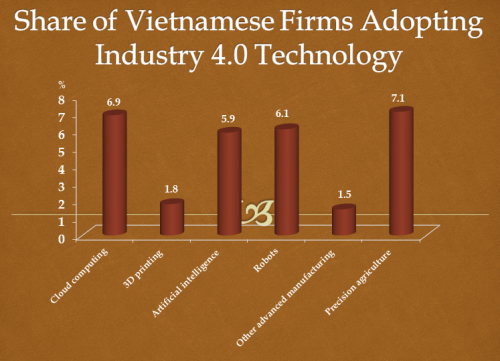WB Survey: Share of VN’s Firms Adopting 4.0 Technologies Is Below 10%
VGP – Adoption of key technologies in Industry 4.0 is still very incipient in Viet Nam with only 6.9% of firms making use of cloud computing for business tasks, according to the World Bank’s survey themed “Firm-level technology adoption in Viet Nam”.
 |
|
Only 1.5% businesses use Big Data or Artificial Intelligence for marketing purposes, and when it comes to fabrication, advanced methods for manufacturing are used by only 6.1% of firms and robots by 5.9% of firms. |
Meanwhile, the technology gap with the use of frontier technologies in some general business functions, such as quality control, production planning, sales, and sourcing and procurement, is large.
The manufacturing sector faces the largest technological gap, larger than services and agricultural firms, the World Bank stressed, adding that the analysis of the main barriers and drivers to technology adoption and use shows the importance of good management quality for technology adoption, and that there is a technology premium associated with exporting activities.
The analysis also shows that firms are largely unaware of the available public policy support for technology upgrading.
Adoption of key technologies in Industry 4.0 is still very incipient in VN
Low rates of adoption of Industry 4.0 technologies are also found in sector specific technologies. In agriculture, only 7.1% of firms use precision agriculture (IoT) technologies, while only 1.8% of firms in manufacturing use additive manufacturing technologies such as 3D printing.
The results, controlling for sector and region fixed effects, show that despite the universal access to electricity, the likelihood of having high quality access (with no outage) is still relatively low (around 25%).
Electricity and especially reliable electricity is an enabling technology of all other technologies. In relation to Industry 3.0 there is almost universal access to mobile, computers, and Internet. Yet, the likelihood of having its own website and use social media for the business is still low. Finally, use of industry 4.0 technologies is very incipient, the survey states.
This paper describes the results of a new firm survey to measure technology use and adoption implemented prior to the Covid-19 pandemic in Viet Nam. It analyzes the use and adoption of technology among Vietnamese firms and identifies some of the key barriers to adoption and diffusion.
The survey implemented in Viet Nam includes a nationally representative random sample of about 1,500 firms with five or more employees from the latest establishment census.
It analyzes the adoption of technologies at the firm-level in Viet Nam through three key angles: (1) Standard measures of technologies associated to different technology revolutions; (2) Technologies applied to general business support functions; and (3) Sector specific technologies.
By Thuy Dung

